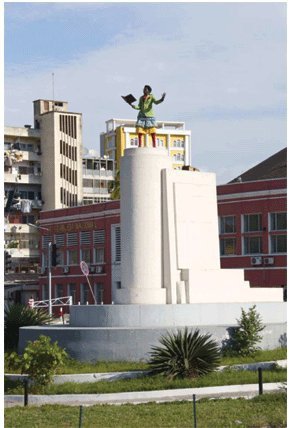Kiluanji Kia Henda
dal 8/2/2013 al 15/3/2013
Segnalato da
8/2/2013
Kiluanji Kia Henda
Kunstraum Innsbruck, Innsbruck
New Man - Homem Novo. The artist focuses his research on the complex postcolonial situation in today's Angola. For the project "Homem Novo" he intends to raise questions around the historical heritage of the object s/monuments by proposing an alternative methodology for the transmission of history.

Kiluanji Kia Henda focuses his research on the complex postcolonial situation in today’s Angola, a country contended for it s oil resources by the world’s superpowers during the Cold War from the year it gained political independence from Portugal (1975), and immediately afterwards ravaged by a brutal civil war (1975-2002).
For the project Homem Novo Kiluanji Kia Henda intends to raise questions around the historical heritage of the object s/monuments by proposing an alternative methodology for the transmission of history. A comparison with the historical gap caused by the decades of conflict in Angola, is one of his main focus of Kia Henda research who re-invents the history in attempt to find a fictitious interpretation of the present. The art in Angola has always being used as a tool for a social change during the post -independence revolution. This tool is now used to materialize the dream of the construction of a Homem Novo - New Man, a citation used in Angola´s anthem, and one of the aims of the revolution for the birth of a new nation.
The series of portraits “Redefining The Power - 75”, were made in the public spaces in Luanda where performers were invited to stand on the pedestals built for the Portuguese monuments during the colonial era. Those monuments were removed in 1975, y ear of Angola independence. Their removal were indeed the first act for the production of this project to become real.
Appropriating the old postcards of the monuments seeing in their original places and doing a portrait of their actual situation, the artist uses those images as a reading of the changes of power showing us their relation with the public spaces. Meanwhile the performance of two young Angolan artists were an attempt to create a monument for the Homem Novo - New Man. During 35 years, those pedestals have been empty and almost invisible to the people in Luanda. The redefinition of the power appears a s a representation of the false heroes but at same time uses the concept of the living sculpture, building an imaginary to perpetuate the sculpture a s symbol of power and also an ephemeral materialization of a dream.
The series of photographs entitled Balumuka (Ambush), is a focus on a transit zone, a kind of open-air cemetery, in the Fort of São Miguel in Luanda - Angola, where various historical object s are left in a state of latency, where history seems to be replayed in private conversations. Some ancient statues of the Angolan history were placed temporally because of the reparation of some public squares so, among Russian tanks and cannons of the cold war, is therefore possible to find the figures of the Angolan sixteenth century heroin Njinga Mbandi, the first Portuguese king Afonso Henriques or Vasco da Gama, together with monumental statues of conquerors from the colonial era. Those object s were moved whilst it was being decided what future awaited them, thus showcasing the problems posed by the idea of a place of preservation that would allow Angola to remember its history. The military armament displayed around this place causes some tension among the monuments and, at same time, shows the different stages and technologies used by the conflict s along the centuries.
Image: Redefining The Power II (Serie 75 with Shunnuz Fiel), 2011, copyright by the artist, courtesy Galleria Fonti, Napoli
More informations:
Elisa Cavagnis 0512/584000 e: office@kunstraum-innsbruck.at
Kunstraum Innsbruck
Maria Theresien Str. 34, Arkadenhof A-6020 Innsbruck
opening hours:
Tue to Fri 12 am – 6 pm
Sat 11 am – 4 pm
closed Sun/Mon/bank holidays
Admission free



